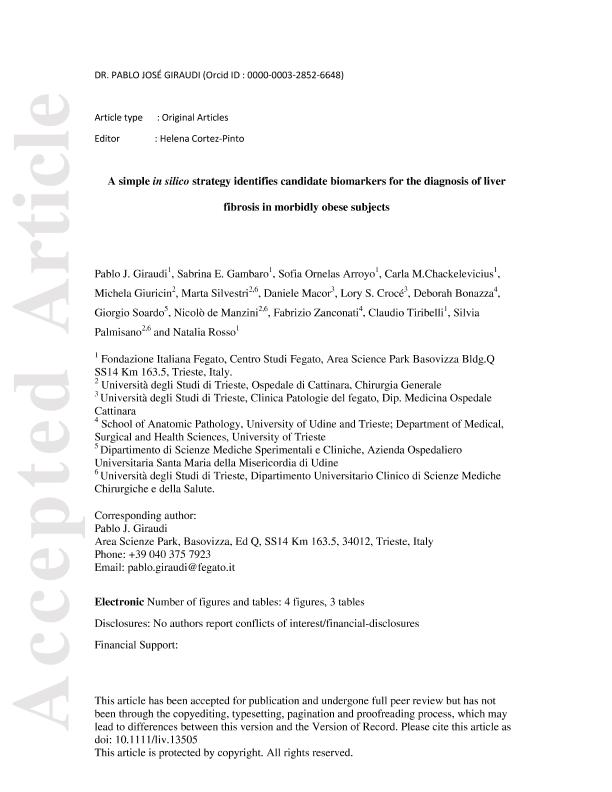Mostrar el registro sencillo del ítem
dc.contributor.author
Giraudi, Pablo J.
dc.contributor.author
Gambaro, Sabrina Eliana

dc.contributor.author
Ornelas Arroyo, Sofia
dc.contributor.author
Chackelevicius, Carla M.
dc.contributor.author
Giuricin, Michela
dc.contributor.author
Silvestri, Marta
dc.contributor.author
Macor, Daniele
dc.contributor.author
Crocé, Lory S.
dc.contributor.author
Bonazza, Deborah
dc.contributor.author
Soardo, Giorgio
dc.contributor.author
de Manzini, Nicolò
dc.contributor.author
Zanconati, Fabrizio
dc.contributor.author
Tiribelli, Claudio

dc.contributor.author
Palmisano, Silvia
dc.contributor.author
Rosso, Natalia
dc.date.available
2018-10-05T16:12:28Z
dc.date.issued
2018-01
dc.identifier.citation
Giraudi, Pablo J.; Gambaro, Sabrina Eliana; Ornelas Arroyo, Sofia; Chackelevicius, Carla M.; Giuricin, Michela; et al.; A simple in silico strategy identifies candidate biomarkers for the diagnosis of liver fibrosis in morbidly obese subjects; Wiley Blackwell Publishing, Inc; Liver International; 38; 1; 1-2018; 155-163
dc.identifier.issn
1478-3223
dc.identifier.uri
http://hdl.handle.net/11336/61759
dc.description.abstract
Background & Aims: Non-alcoholic fatty liver disease (NAFLD) is a chronic liver disorder, tightly associated with obesity. The histological spectrum of the disease ranges from simple steatosis to steatohepatitis, with different stages of fibrosis, and fibrosis stage is the most significant predictor of mortality in NAFLD. Liver biopsy continues to be the gold standard for its diagnosis and reliable non-invasive diagnostic tools are unavailable. We investigated the accuracy of candidate proteins, identified by an in silico approach, as biomarkers for diagnosis of fibrosis. Methods: Seventy-one morbidly obese (MO) subjects with biopsy-proven NAFLD were enrolled, and the cohort was subdivided according to minimal (F0/F1) or moderate (F2/F3) fibrosis. The plasmatic level of CD44 antigen (CD44), secreted protein acidic and rich in cysteine (SPARC), epidermal growth factor receptor (EGFR) and insulin-like growth factor 2 (IGF2) were determined by ELISA. Significant associations between plasmatic levels and histological fibrosis were determined by correlation analysis and the diagnostic accuracy by the area under receiver operating characteristic curves (AUROC). Results: Eighty-two percentage of the subjects had F0/F1 and 18% with F2/F3 fibrosis. Plasmatic levels of IGF2, EGFR and their ratio (EGFR/IGF2) were associated with liver fibrosis, correlating inversely for IGF2 (P <.006) and directly (P <.018; P <.0001) for EGFR and EGFR/IGF2 respectively. The IGF2 marker had the best diagnostic accuracy for moderate fibrosis (AUROC 0.83), followed by EGFR/IGF2 ratio (AUROC 0.79) and EGFR (AUROC 0.71). Conclusions: Our study supports the potential utility of IGF2 and EGFR as non-invasive diagnostic biomarkers for liver fibrosis in morbidly obese subjects.
dc.format
application/pdf
dc.language.iso
eng
dc.publisher
Wiley Blackwell Publishing, Inc

dc.rights
info:eu-repo/semantics/openAccess
dc.rights.uri
https://creativecommons.org/licenses/by-nc-sa/2.5/ar/
dc.subject
Biomarkers
dc.subject
In Silico Strategy
dc.subject
Liver Fibrosis
dc.subject
Morbidly Obese
dc.subject.classification
Otras Biotecnologías de la Salud

dc.subject.classification
Biotecnología de la Salud

dc.subject.classification
CIENCIAS MÉDICAS Y DE LA SALUD

dc.title
A simple in silico strategy identifies candidate biomarkers for the diagnosis of liver fibrosis in morbidly obese subjects
dc.type
info:eu-repo/semantics/article
dc.type
info:ar-repo/semantics/artículo
dc.type
info:eu-repo/semantics/publishedVersion
dc.date.updated
2018-09-04T19:56:03Z
dc.journal.volume
38
dc.journal.number
1
dc.journal.pagination
155-163
dc.journal.pais
Reino Unido

dc.journal.ciudad
Londres
dc.description.fil
Fil: Giraudi, Pablo J.. Centro Studi Fegato; Italia
dc.description.fil
Fil: Gambaro, Sabrina Eliana. Consejo Nacional de Investigaciones Científicas y Técnicas; Argentina. Centro Studi Fegato; Italia
dc.description.fil
Fil: Ornelas Arroyo, Sofia. Centro Studi Fegato; Italia
dc.description.fil
Fil: Chackelevicius, Carla M.. Centro Studi Fegato; Italia
dc.description.fil
Fil: Giuricin, Michela. Università degli Studi di Trieste; Italia
dc.description.fil
Fil: Silvestri, Marta. Università degli Studi di Trieste; Italia
dc.description.fil
Fil: Macor, Daniele. Università degli Studi di Trieste; Italia
dc.description.fil
Fil: Crocé, Lory S.. Università degli Studi di Trieste; Italia
dc.description.fil
Fil: Bonazza, Deborah. University of Udine and Trieste; Italia
dc.description.fil
Fil: Soardo, Giorgio. Universitaria Santa Maria della Misericordia di Udine; Italia
dc.description.fil
Fil: de Manzini, Nicolò. Università degli Studi di Trieste; Italia
dc.description.fil
Fil: Zanconati, Fabrizio. University of Udine and Trieste; Italia
dc.description.fil
Fil: Tiribelli, Claudio. Centro Studi Fegato; Italia
dc.description.fil
Fil: Palmisano, Silvia. Università degli Studi di Trieste; Italia
dc.description.fil
Fil: Rosso, Natalia. Centro Studi Fegato; Italia
dc.journal.title
Liver International

dc.relation.alternativeid
info:eu-repo/semantics/altIdentifier/doi/https://dx.doi.org/10.1111/liv.13505
dc.relation.alternativeid
info:eu-repo/semantics/altIdentifier/url/https://onlinelibrary.wiley.com/doi/abs/10.1111/liv.13505
Archivos asociados
